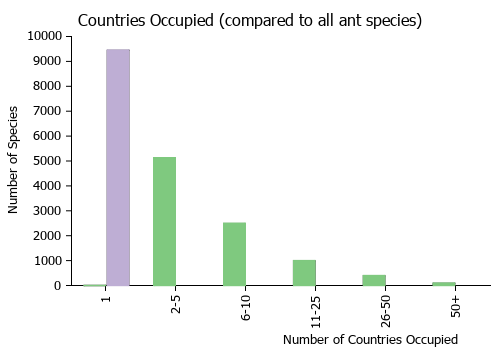Colobopsis phragmaticola
| Colobopsis phragmaticola | |
|---|---|

| |
| Scientific classification | |
| Kingdom: | Animalia |
| Phylum: | Arthropoda |
| Class: | Insecta |
| Order: | Hymenoptera |
| Family: | Formicidae |
| Subfamily: | Formicinae |
| Tribe: | Camponotini |
| Genus: | Colobopsis |
| Species: | C. phragmaticola |
| Binomial name | |
| Colobopsis phragmaticola (Donisthorpe, 1943) | |
Identification
Keys including this Species
Distribution
Distribution based on Regional Taxon Lists
Oriental Region: India (type locality).
Distribution based on AntMaps
Distribution based on AntWeb specimens
Check data from AntWeb
Countries Occupied
| Number of countries occupied by this species based on AntWiki Regional Taxon Lists. In general, fewer countries occupied indicates a narrower range, while more countries indicates a more widespread species. |

|
Estimated Abundance
| Relative abundance based on number of AntMaps records per species (this species within the purple bar). Fewer records (to the left) indicates a less abundant/encountered species while more records (to the right) indicates more abundant/encountered species. |

|
Biology
Castes
Images from AntWeb

| |
| Holotype of Camponotus phragmaticola. Queen (alate/dealate). Specimen code casent0903592. Photographer Will Ericson, uploaded by California Academy of Sciences. | Owned by NHMUK, London, UK. |
Nomenclature
The following information is derived from Barry Bolton's Online Catalogue of the Ants of the World.
- phragmaticola. Camponotus (Colobopsis) phragmaticola Donisthorpe, 1943b: 205 (q.) INDIA (Kerala).
- Type-material: 4 syntype queens.
- Type-locality: India: Travancore, Tenmalai, 500-800 ft, 11-17.x.1938, (Colombo Museum Expd. Southern India) (G.M. Henry)
- Type-depository: BMNH.
- Combination in Colobopsis: Ward, Blaimer & Fisher, 2016: 350.
- Status as species: Chapman & Capco, 1951: 225; Bolton, 1995b: 117; Tiwari, 1999: 72; Karmaly & Narendran, 2006: 102; Bharti, Guénard, et al. 2016: 25.
- Distribution: India.
Description
Queen
Donisthorpe (1943): Head longer than broad, cylindrical, obliquely truncate anteriorly, the truncate surface circular, very narrowly margined, comprising the frontal surface of the mandibles, the central parts of the cheeks and the greater part of the clypeus; mandibles flat, broadly triangular, masticatory border armed with four teeth at apex; clypeus narrow, longer than broad, continued on top of head beyond the circular margins, sides margined, centre with a raised ridge or carina; frontal carina widely separated, rather short, only slightly raised, divergent; a short shallow scrobe con tinues from beneath centre of frontal carins to a little beyond their base; eyes large, oval, flat; ocelli rather small; antenna moderate, 12-jointed, inserted in the .middle of the frontal carine, scape curved, rather flat at apex, funiculus thickened to apex. Thorax long, narrow, narrowed anteriorly and posteriorly, broadest before in sertion of wings; pronotum short, transverse, embracing sides of mesonotum; mesonotum considerably longer than broad, convex in front, rather flat towards baso; præ scutellum narrow, transverse, flat; scutellum broad oval, transverse, rather flat; sutures between praescutellum and mesonotum, mesonotum and metanotum, and metanotum and epinotum rather deep; melanotum narrow, transverse, flat; epinotum convex, rounded, no marked angle between dorsal surface and declivity. Petiole furnished with a short, rather low node, upper surface rounded, posterior surface longer than anterior surface; gaster long oval, rather flat above, narrowed to apex, first segment rounded in front. Legs moderate, femora compressed. Wings moderate, rather narrow, iridiscent, pterostigma and veins pale yellow, typical Camponotus venation.
Head brownish red, vertex blackish, thorax and petiole yellowish brown, gaster black (brown in some specimens) with apex of segments narrowly yellow, legs and antenna reddish yellow, eyes black. Front part of head rather rugosely punctured, with some fine longitudinal striae behind the circular margin; rest of head, thorax and gaster very finely and delicately shagreened with some very minute punctures, clothed with a few short outstand ing yellow hairs on gaster and some very short fine decumbent ones.
Length: 6.8 - 7 mm
References
- Dhadwal, T., Bharti, H. 2024. Colobopsis kapilashi sp. nov. (Hymenoptera: Formicidae) a new ant species from India with a key to the Indian species. Journal of Asia-Pacific Biodiversity (doi:10.1016/j.japb.2024.10.012).
- Donisthorpe, H. 1943b. Ants from the Colombo Museum Expedition to Southern India, September-October, 1938. Ann. Mag. Nat. Hist. 11(10): 196-208. (page 205, queen described)
- Ward, P.S., Blaimer, B.B., Fisher, B.L. 2016. A revised phylogenetic classification of the ant subfamily Formicinae (Hymenoptera: Formicidae), with resurrection of the genera Colobopsis and Dinomyrmex. Zootaxa 4072 (3): 343–357 (doi:10.11646/zootaxa.4072.3.4).
References based on Global Ant Biodiversity Informatics
- Dad J. M., S. A. Akbar, H. Bharti, and A. A. Wachkoo. 2019. Community structure and ant species diversity across select sites ofWestern Ghats, India. Acta Ecologica Sinica 39: 219–228.
- Presty J., and K. A. Karmaly. 2016. A study on the diversity and distribution of genus Camponotus Mayr (Hymenoptera: Formicidae) in Kerala: ecologically significant agents in ecosystems functioning. In: Chakravarhty A. K, and S. Sridhara (eds), Arthropod diversity and conservation in the tropics and sub-tropics. Springer edition. Pages 255-270.

